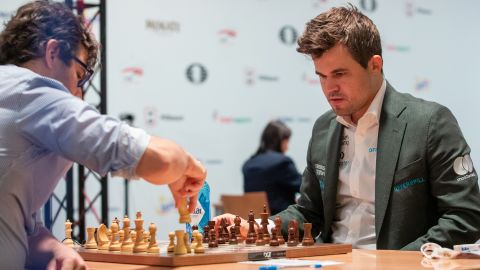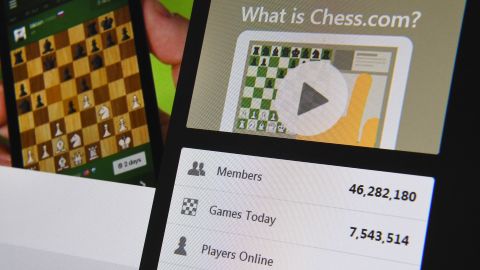CNN
—
From Netflix shows such as “The Queen’s Gambit” to its rock and roll superstar Magnus Carlsen, the popularity of chess has never been stronger.
As the game embraces the digital world, chess has only continued to grow and is now eagerly consumed by all generations.
Online platform Chess.com says it now has more than 102 million users signed up – a 238% increase from January 2020 – with 7.5 million active users every day.
Meanwhile, some of the sport’s very best players have amassed huge social media followings by streaming games online. The game is so embedded in the public’s consciousness that there is now even such a thing as a chess influencer.
With the game evolving year on year, and with Carlsen playing in a tournament dubbed “chess Wimbledon” on Saturday, CNN takes a look at some of the most popular chess variants with the help of Grandmaster and three-time British Champion David Howell.
Most will be familiar with the rules of classical chess, a game that has been around in some form or other for over a thousand years.
Players compete to checkmate their opponent and have a long time to do so.
The clock, which tracks the time left for both players, usually starts at 90 minutes but games can go on for much longer.
For the upcoming FIDE World Cup this year, for example, players will have 90 minutes for the first 40 moves, followed by 30 minutes for the rest of the game. Players also receive an extra 30 seconds for each move they make, meaning individual games can last for hours.
In 2021, Carlsen beat Ian Nepomniachtchi after seven hours, 45 minutes and 136 moves, the longest single game in world championship history. That was the sixth match of the best-of-14-game series, though Carlsen only needed 11 games to win.
“Classical is the most historic kind of time control. In the old days, they used to have hours or even days at a time for their game,” Howell told CNN.
“So it’s a longer form. I think the average classical game takes about four hours and it’s all about endurance.
“Objectively, the level is very high. There are very few blunders and often it’s about incremental gains. You have to add up all these small advantages to outlast your opponent.”
Due to the time available to think about your next move, draws at the top level are very common and there is practically no margin for error.
Howell says all players have databases available to them to study all of their opponent’s previous games, meaning they can plan ahead for matches.
Some players, including Howell himself, can very occasionally predict the next 20 moves of a game because of the time given to analyze the board.
Carlsen is the current world classical champion and has been since 2013.
For those who struggle to stay engaged with the classical version of chess, there is a faster option available.
Rapid has the same rules as classical but players have between 10 and 60 minutes to make their moves.
With the clock ticking, players tend to make more mistakes with draws less likely.
“Here there is a heavy emphasis on the opening because you’ve got such a short amount of time,” Howell said.
“You don’t want to get into trouble early in the game because you don’t really have time to think and to fight back.”
Howell says these games tend to become a scramble for time by the end, with players taking more risks.
In the past, some of the biggest names in chess wouldn’t have touched these faster versions but nowadays, the sport’s biggest stars take it seriously.
As a result, the standard is still very high with perhaps only one mistake a game due to the time pressure.
In addition to checkmate, players can also lose if they run out of time.
Carlsen, yet again, is the world rapid champion after winning the title in December 2022.

If you need a quicker dopamine hit, blitz chess is an even faster version of the sport and players are permitted no more than 10 minutes, according to the game’s governing body FIDE.
Howell, though, says most blitz games are between three to five minutes long.
The time allocated can also include incremental additions. For example, 5/1 blitz would refer to the number of minutes players start with (five) and the number of additional seconds (one) players receive after making their move.
These games require players to think fast and move at lightning speed.
“Blitz is fast and furious. It’s a lot about instincts, it’s all about speed,” Howell said.
“Often the maximum you have on the clock is five minutes each for the whole game. But nowadays, three minutes is kind of the standard but you do get, for example, two seconds every move, like a small buffer, an increment,” added Howell, referring to other blitz variants.
“It does pay off to be very aggressive quite often, because attacking is easier than defending.”
Carlsen is again the world champion has a worthy rival in US player Hikaru Nakamura.
The 35-year-old Nakamura represents a new era of chess and has amassed 1.6 million followers on streaming platform Twitch by broadcasting his online games.
Howell says both Carlsen and Nakamura have an incredible ability to make snap decisions and are able to solve situations within a split second.
Despite the years of practice, even the biggest stars make glaring errors. But according to Howell, that’s all part of the fun.
“It’s like going from a five setter in tennis down to just the final tiebreak,” Howell said, speaking to the difference between blitz and classical.
“Sometimes you just get unlucky. There’s far less control over your own fate.”
If you have an even greater need for speed there is bullet chess which, as its name suggests, is the fastest of all variants and an offshoot of blitz.
It’s almost always played online with players usually having just one minute to make all their moves.
Although chess purists have widely adopted the other time constraints, bullet chess is often looked at as a bit of a lottery.
“It’s more about just surprising the opponent at any cost,” Howell said.
“Your moves don’t need to be the best ones but surprise value is the key because if your opponent burns 10 or 20 seconds on one move, they’ve basically lost all the time and lost the game.”
With bullet chess almost exclusively played digitally, Howell says the variant has become something of an esport, with players needing to rely on their mouse dexterity as much as their understanding of the game.

The shift to a digital landscape has also seen a change in the psychology involved in playing the game.
“A lot of players perform better if they don’t see their opponent because they don’t get involved with the mind games,” added Howell.
“For example, if I were to play Magnus Carlsen and I didn’t know it was Magnus, I think I would score far better than if I were sitting across the board from him because there’s that kind aura around him, that air of dominance.
“If he makes a gesture or frowns, suddenly you panic and you make a terrible decision. You can automatically play this submissive role and the top players often overwhelm their opponents psychologically.
“Online, it’s easier to stay calm. You don’t feel your opponent’s breath on your face.”
Finally, there is the wildcard variant called Chess 960, or Fischer random chess.
Created by former world chess champion Bobby Fischer, the game is different not just for its time constraints but for the positioning of its pieces.
While the pawns are still lined up on the second row, the pieces behind are placed randomly.
It prevents players from planning their moves ahead of time and Howell believes this is a variant that will continue to grow.
“There’s 960 different starting positions and therefore you can’t really memorize the opening stage,” he said.
“Basically, each player comes fresh to the game and it’s all about understanding rather than who’s got a better memory.”